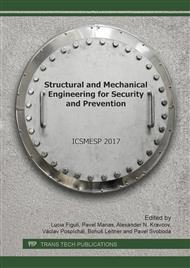p.242
p.248
p.261
p.268
p.274
p.279
p.286
p.292
p.300
Prediction of the Fatigue Life of the Vibrational Sieve Supporting Beam
Abstract:
Vibrational sieves are exposed to exceptionally high cyclic loading during their working life and that is the reason why the special attention should be paid to estimates of the fatigue life of their structural elements, as well as to design with respect to fatigue fracture. Any change in the design appearance of the structural component must be carefully analyzed, since even the rearrangement of the components' elements layout, with keeping all the sizes constant, can cause serious consequences to the particular component's fatigue life. The research subject considered in this paper is the remaining fatigue life of the carrying beam, as well as the suggestions for improving the working life of the vibrational sieve. The Paris' law was used for estimates of the average crack propagation rate. From the presented diagram of the initial crack length versus the remaining working life one could see that the fatigue life decreases with the crack length increase. When the initial crack length reaches a value a little less than a half of the critical crack length, the remaining fatigue life starts to drop abruptly.
Info:
Periodical:
Pages:
274-278
Citation:
Online since:
September 2017
Authors:
Keywords:
Price:
Сopyright:
© 2017 Trans Tech Publications Ltd. All Rights Reserved
Share:
Citation:


